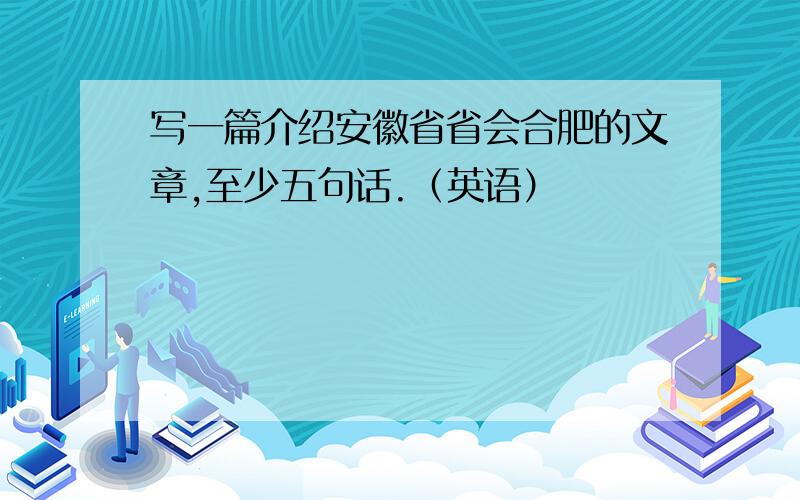写一篇介绍安徽省省会合肥的文章,至少五句话.(英语)
来源:学生作业帮助网 编辑:作业帮 时间:2024/11/29 09:42:10

写一篇介绍安徽省省会合肥的文章,至少五句话.(英语)
写一篇介绍安徽省省会合肥的文章,至少五句话.(英语)
写一篇介绍安徽省省会合肥的文章,至少五句话.(英语)
From the 8th to the 6th century BC,Hefei was the site of the small state of Shu,later a part of the Chu kingdom.Many archaeological finds dating from this period have been made.The name Hefei was first given to the county set up in the area under the Han dynasty in the 2nd century BC.During the 4th to the 6th century AD,this crucial border region between northern and southern states was much fought over; its name and administrative status were consequently often changed.During the Sui (581–618) and Tang (618–907) periods,it became the seat of Lu prefecture — a title it kept until the 15th century,when it became a superior prefecture named Luzhou.
In 3rd century AD,the famous Three Kingdoms battle,Battle of Hefei,was fought at what is currently Leisure Ford (逍遥津) in Hefei.General Zhang Liao of the Kingdom of Wei commanding 800 picked cavalry defeated the 200,000-man army of the Kingdom of Wu.Several decades of warring in Hefei between Wu and Wei followed this battle.
The present city dates from the Song dynasty (960–1126),the earlier Hefei having been some distance farther north.During the 10th century,it was for a while the capital of the independent Wu kingdom (902–938) and was an important center of the Southern Tang state (937–975).
After 1127 it became a center of the defenses of the Southern Song dynasty (1126–1279) against the Jin (Jurchen) invaders,as well as a flourishing center of trade between the two states.When the Chinese Republic was founded in 1911,the superior prefecture was abolished,and the city took the name of Hefei.
The city was known as Luzhou (庐州; pinyin Lúzhōu) during the Ming and Qing Dynasties (after 14th century to 19th century).Hefei was the temporary capital for Anhui from 1853 to 1862.It was renamed as Hefei County in 1912.Following the Chinese victory in the Second Sino-Japanese War in 1945,Hefei was made the capital of Anhui.
Before World War II,Hefei remained essentially an administrative center and the regional market for the fertile plain to the south.It was a collecting center for grain,beans,cotton,and hemp,as well as a center for handicraft industries manufacturing cloth,leather,bamboo goods,and ironware.
The construction in 1912 of the Tianjin–Puzhou railway,farther east,for a while made Hefei a provincial backwater,and much of its importance passed to Bengbu.In 1932–36,however,a Chinese company built a railway linking Hefei with Yuxikou (on the Yangtze opposite Wuhu) to the southeast and with the Huai River at Huainan to the north.While this railway was built primarily to exploit the rich coalfield in northern Anhui,it also did much to revive the economy of the Hefei area by taking much of its produce to Wuhu and Nanjing.
Although Hefei was a quiet market town of only about 30,000 in the mid-1930s,its population grew more than tenfold in the following 20 years.The city's administrative role was strengthened by the transfer of the provincial government from Anqing in 1949,but much of its new growth derived from its development as an industrial city.A cotton mill was opened in 1958,and a thermal generating plant,using coal from Huainan,was established in the early 1950s.It also became the seat of an industry producing industrial chemicals and chemical fertilizers.In the late 1950s an iron and steel complex was built.In addition to a machine-tool works and engineering and agricultural machinery factories,the city has developed an aluminum industry and a variety of light industries.There are several universities based in the city.